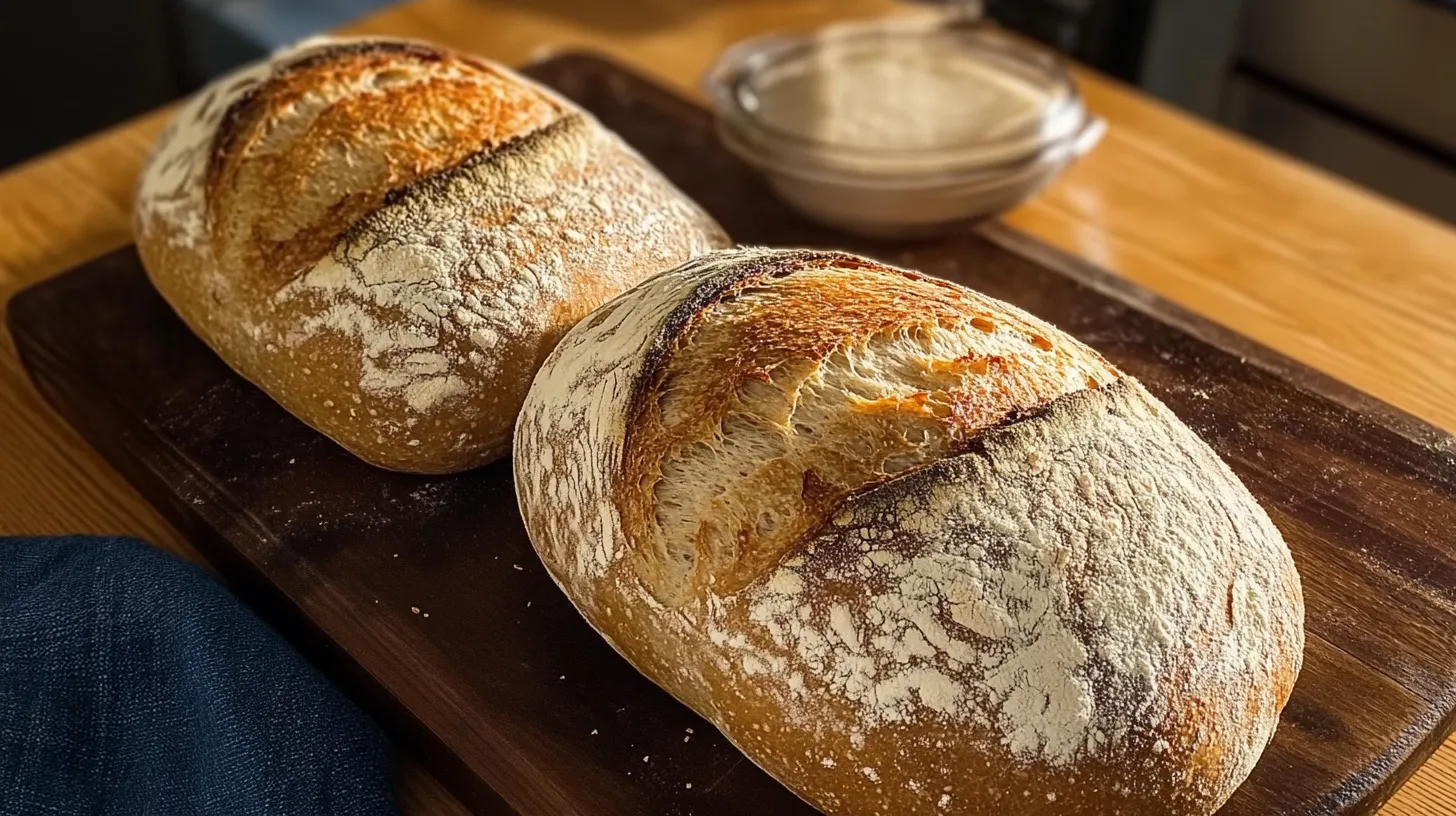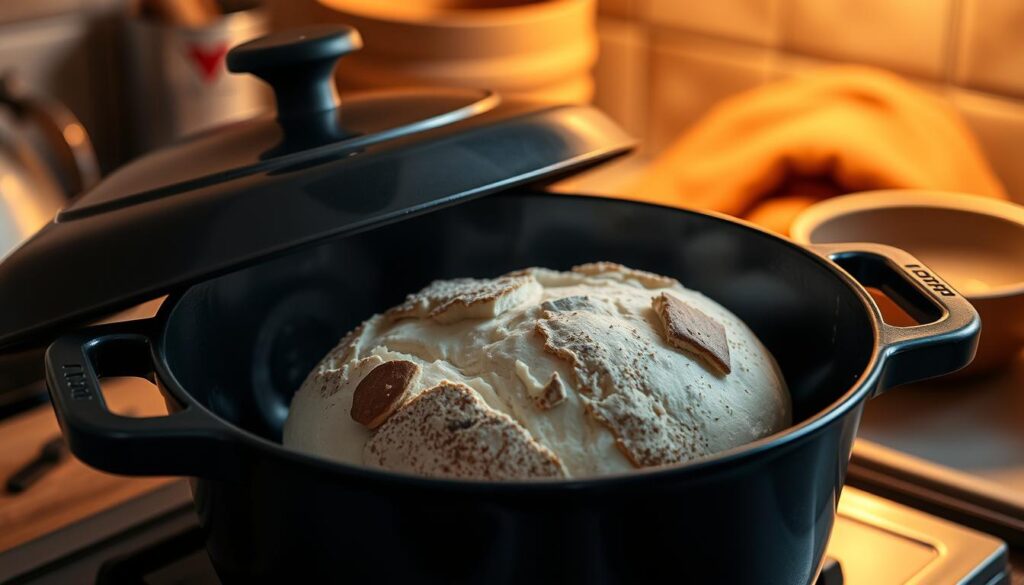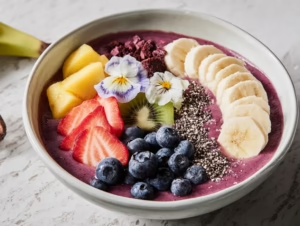Are you tired of store-bought sourdough bread lacking the flavor and nutrition you crave? You’re not alone! Many of us have been there, but what if you could create a delicious, crusty loaf at home with minimal effort?
I’m excited to share this super simple sourdough recipe that’s perfect for beginners! Using just four basic ingredients and a hands-off approach, you can enjoy the incredible taste and health benefits of homemade bread without disrupting your busy schedule.
This recipe breaks down the process into manageable steps, making it easy to follow along and achieve a perfect loaf with a crispy crust and soft interior.

Easy Sourdough Bread
Equipment
- Large mixing bowl
- Dutch oven or baking stone
- Bench scraper
- Kitchen scale
- Clean towel
- Proofing basket or bowl
Ingrédients
- 500 g bread flour
- 375 g water lukewarm
- 100 g active sourdough starter
- 10 g salt
Instructions
Mix the Dough:
- In a large bowl, mix flour and water until just combined. Let rest for 30 minutes (autolyse).
Add Starter and Salt:
- Add the sourdough starter and salt. Mix well until dough becomes sticky and elastic.
Bulk Fermentation:
- Cover the bowl and let the dough rise at room temperature for 4-6 hours, folding every 30 minutes for the first 2 hours.
Shape and Proof:
- Shape the dough into a round loaf and place in a floured proofing basket. Cover and refrigerate overnight (12-18 hours).
Bake:
- Preheat oven to 475°F (245°C) with Dutch oven inside. Place dough into Dutch oven, score the top, and bake covered for 20 minutes. Remove lid and bake another 20-25 minutes until golden brown.
Cool and Serve:
- Remove bread and cool on a wire rack for at least 1 hour before slicing.
Nutrition
Table of Contents
Key Takeaways
- Simple sourdough bread recipe for beginners
- Hands-off approach with minimal effort required
- Uses just four basic ingredients
- Perfect for busy lives and new to sourdough
- Delicious, crusty loaf with a soft interior
Why This Easy Sourdough Bread Recipe is Perfect for Beginners
I’ve crafted this sourdough recipe with beginners in mind, making it easy to achieve great results. This recipe is designed to be incredibly forgiving, allowing you to mix the dough, let it rest, and come back later to shape and bake – all without requiring precise timing or technical skills.
Benefits of Making Your Own Sourdough
Making your own sourdough bread has several benefits. Not only do you get to enjoy the delicious taste and texture of freshly baked bread, but you also have control over the ingredients used. This means you can avoid preservatives and additives found in commercial bread. Moreover, the process of making sourdough can be therapeutic, allowing you to disconnect from the hustle and bustle of daily life.
By making your own sourdough, you’ll also gain a sense of accomplishment and confidence in your baking abilities. The long fermentation time used in this recipe helps to break down some of the gluten, making it easier to digest for some people.
| Benefits | Description |
|---|---|
| Control Over Ingredients | Avoid preservatives and additives found in commercial bread |
| Therapeutic Process | Allows you to disconnect from daily life |
| Easier to Digest | Long fermentation time breaks down some gluten |
What Makes This Recipe Different
This sourdough recipe stands out from others due to its simplicity and flexibility. It uses a smaller percentage of starter in the dough, which allows for a longer fermentation time. This means you can mix the dough and let it rest throughout the day or overnight, making it fit into your schedule.
The recipe also eliminates the need for complicated techniques like extensive kneading. Instead, it relies on time to develop the gluten naturally, making it a truly hands-off process. As a result, you’ll get a soft, tender loaf with a closed crumb that’s perfect for sandwiches and toast.
Understanding Sourdough Bread Basics
As a beginner, understanding sourdough bread basics is your first step to baking perfection. Sourdough bread is more than just a type of bread; it’s a journey into the world of natural fermentation and flavors. Let’s start by breaking down what sourdough bread is and why it’s so unique.
What is Sourdough Bread?
Sourdough bread is made using a natural starter culture instead of commercial yeast. This starter culture is a mixture of wild yeast and bacteria that ferments the sugars in the dough, producing lactic acid and creating the bread’s characteristic tang. The process of making sourdough bread is slower and more labor-intensive, but the result is a bread that’s not only delicious but also has several health benefits.
The Science Behind Fermentation
The fermentation process in sourdough bread is what sets it apart from other types of bread. During fermentation, the lactic acid bacteria in the starter break down some of the starches and gluten, making the bread easier to digest for some people. The fermentation process also increases the bioavailability of nutrients, making it a healthier option.
Health Benefits of Sourdough
Sourdough bread offers several health benefits due to its unique fermentation process. Many people find sourdough bread easier to digest than regular bread because the long fermentation process pre-digests much of the gluten. The lactic acid bacteria help neutralize phytic acid, allowing for better absorption of minerals like zinc, magnesium, and iron. Additionally, sourdough has a lower glycemic index and can support gut health.
- The long fermentation process breaks down gluten, making it easier to digest.
- Lactic acid bacteria help increase the bioavailability of minerals.
- Sourdough has a lower glycemic index compared to regular bread.
All About Sourdough Starters
Before you can bake your first loaf of sourdough, you need to create and maintain a sourdough starter. This natural yeast culture is the heart of sourdough baking, giving your bread its unique flavor and texture.
What is a Sourdough Starter?
A sourdough starter is a mixture of flour and water that has been colonized by wild yeast and bacteria. It’s a living, breathing entity that needs to be fed regularly to stay healthy and active. Creating a starter from scratch can be a fun and rewarding process.
How to Know When Your Starter is Ready
So, how do you know when your starter is ready to use? A healthy starter should be bubbly, frothy, and nearly double in size after feeding. It should have a tangy aroma, similar to sour milk or ripe fruit. If you’re unsure, it’s always better to wait a bit longer or give it another feeding.
Feeding and Maintaining Your Starter
Feeding your sourdough starter is crucial for maintaining its health and activity. I like to use a small ratio of starter to flour and water when feeding, so it rises slowly over several hours. Here are some key tips for maintaining your starter:
- A regular feeding schedule is crucial for a healthy, active starter – consistency really matters here!
- For my regular maintenance routine, I mix 10g of starter with 25g each of flour and water, creating a 1:2.5:2.5 ratio that rises reliably over 8-12 hours.
- You can adjust these ratios to fit your schedule – using less starter and more flour/water creates a slower rise, while more starter speeds things up.
- Room temperature greatly affects how quickly your starter rises – in my 68°F kitchen, it takes about 12 hours to peak, but in warmer environments, it might only take 4-6 hours.
- If you’re not baking regularly, you can store your starter in the refrigerator and feed it just once a week – just remember to bring it back to room temperature and feed it a couple of times before baking.
By following these tips and maintaining a consistent feeding schedule, you’ll be able to keep your active sourdough starter healthy and thriving, ready to make delicious sourdough bread whenever you want.
Essential Equipment for Baking Sourdough Bread
The right tools can elevate your sourdough baking game and help you achieve professional results. To get started, you’ll need a few essential pieces of equipment that make the baking process easier and more enjoyable.
Dutch Oven
A Dutch oven is a crucial piece of equipment for baking sourdough bread. It provides the steamy environment necessary for creating that perfect crust. When choosing a Dutch oven, look for one that is preheated easily and retains heat well.

Other Helpful Tools
While a Dutch oven is essential, there are other tools that can make the sourdough baking process easier. For the best results, use a kitchen scale to measure your ingredients accurately.
- A kitchen scale is absolutely essential for consistent results – measuring ingredients by weight rather than volume makes a huge difference in sourdough baking.
- A bench scraper is another handy tool for handling and shaping sticky dough.
- A banneton or a bowl lined with a well-floured kitchen towel can help your dough maintain its shape during the final rise.
- Scoring your bread requires a sharp implement, such as a lame, sharp knife, or razor blade.
- Parchment paper is also a must-have for transferring dough to a hot Dutch oven without deflating it.
Ingredients for Easy Sourdough Bread Recipe
I’ve found that the secret to a great sourdough bread lies in its four basic ingredients. Understanding these components is crucial for achieving the perfect loaf.
The Four Basic Ingredients
The beauty of sourdough is in its simplicity. You need just four main ingredients to make a delicious loaf: flour, water, salt, and your sourdough starter. The type of flour you choose can significantly affect the final product. For this sourdough recipe, you’ll need 375g of bread flour. The quality of your flour directly impacts the texture and flavor of your dough. Using the right flour helps create a better dough structure.
Flour Options and Substitutions
While bread flour is ideal for this sourdough recipe due to its high protein content, you can also use all-purpose flour as a substitute. If you choose to use all-purpose flour, reduce the amount of water to 325g to achieve the right dough consistency. For those looking to experiment, you can substitute up to 20% of the bread flour with whole wheat, rye, or spelt flour for different flavors and textures.
| Flour Type | Protein Content | Best For |
|---|---|---|
| Bread Flour | High (12-14%) | Sourdough, artisan bread |
| All-Purpose Flour | Medium (10-12%) | General baking, sourdough (with adjustments) |
| Whole Wheat Flour | High (14-15%) | Adding depth, nutrition to sourdough |
« The quality of your ingredients is directly reflected in the quality of your bread. »
Step-by-Step Sourdough Bread Instructions
Now that we’ve covered the basics, let’s dive into the step-by-step process of making your very own sourdough bread from scratch! This is where the magic happens, and with a little patience, you’ll be enjoying your homemade bread in no time.
Preparing Your Active Sourdough Starter
Before we begin mixing our dough, we need to ensure our sourdough starter is active and ready to go. This means it should be bubbly, have a slightly sour smell, and have doubled in size after feeding. If your starter is new, you might need to feed it a few times before it’s ready. Make sure it’s at its peak activity before proceeding to mix the dough.
Mixing the Dough
To mix the dough, combine 1 cup of warm water, 1/4 cup of active sourdough starter, and 3 cups of bread flour in a large bowl. Mix until the dough comes together in a shaggy mass. Don’t overmix; it’s okay if it’s a bit rough at this stage. Cover the bowl with a damp cloth and let it rest for 20-30 minutes, a process known as autolyse. After the autolyse, add salt and mix until the dough starts to come together in a more cohesive ball.
Stretch and Fold Technique
The stretch and fold technique is crucial for developing the dough’s gluten. To do this, wet your hands and gently grab the dough from underneath, stretching it outwards and then folding it back onto itself. Repeat this process a few times, turning the bowl 90 degrees after each fold. You’ll do this a total of 4-6 times over the next couple of hours. This technique helps to distribute the yeast evenly and develops the dough’s structure.
Bulk Fermentation (First Rise)
After the initial mixing and a few rounds of stretch and fold, the dough will start its first rise, also known as bulk fermentation. This is where the magic of fermentation happens, and your dough starts to develop that characteristic sourdough flavor. Let the dough rest in a warm, draft-free place for about 4-5 hours, or until it has visibly expanded and has a few large bubbles on the surface.
Shaping the Dough
Once the bulk fermentation is complete, it’s time to shape the dough. Gently deflate the dough and shape it into a round or oblong loaf. Place the shaped dough into a banneton or a proofing basket lined with parchment paper, making sure the seam is facing upwards. Be gentle to avoid over-working the dough.
Final Proofing (Second Rise)
After shaping, the dough needs a final rise, also called proofing, before baking. You can do this at room temperature for 1-2 hours or in the refrigerator for 8-15 hours. I prefer the cold proofing method because it’s more forgiving with timing and develops more flavor. To cold proof, cover the banneton with plastic wrap or place it in a plastic bag, then refrigerate it overnight. The cold temperature slows down fermentation while still allowing flavor development.
- You’ll know the dough is properly proofed when it has visibly expanded and feels puffy but still has some resistance when you gently press it with your finger.
- This final proofing stage is crucial – under-proofed bread will be dense with uneven holes, while over-proofed bread will flatten in the oven and have a gummy texture.
Let the dough rest for 12-15 hours in the refrigerator or 3-4 hours at room temperature. The longer rise time in the refrigerator makes it easier to score and can result in a better oven spring.
Baking Your Sourdough Bread to Perfection
The moment of truth arrives when you bake your sourdough bread to perfection. This is where all your hard work pays off, and you get to enjoy the fruits of your labor. Baking sourdough bread is a two-phase process that requires attention to detail and a bit of patience.
Preheating Your Dutch Oven
Preheating your Dutch oven is a crucial step in achieving that perfect crust. I preheat my Dutch oven to 450°F (232°C) with the lid on. This ensures that the oven is hot and ready for baking. Make sure to preheat it for at least 30 minutes before baking to get the best results.
Scoring Techniques
Scoring your bread is not just about aesthetics; it also helps control how the bread expands during baking. I like to use a sharp razor or a lame to score my bread. A simple slash or a more intricate design can be used, depending on your preference. The key is to make a clean cut without tearing the dough.
Baking Times and Temperatures
Now, let’s get to the baking! Place the lid back on the Dutch oven and put it into the hot oven. Bake for 20 minutes with the lid on to trap the steam and allow the bread to rise. After 20 minutes, remove the lid and continue baking for another 20-25 minutes to develop that beautiful golden-brown crust. The internal temperature of the bread should reach 205-210°F (96-99°C) when fully baked.
| Baking Phase | Time (minutes) | Lid Position | Oven Temperature |
|---|---|---|---|
| Initial Baking | 20 | On | 450°F (232°C) |
| Final Baking | 20-25 | Off | 450°F (232°C) |
To ensure your bread is fully baked, check the internal temperature with an instant-read thermometer. If it’s browning too quickly, you can lower the oven temperature to 425°F (218°C) for the remainder of the baking time.
Sample Baking Schedules
Whether you’re an early riser or a night owl, you can bake delicious sourdough bread. Having a schedule can help you plan and ensure that your bread turns out perfectly. Here, I’ll share two sample baking schedules to fit different lifestyles.
Morning Baking Schedule
If you’re someone who enjoys baking in the morning, here’s a schedule you can follow. Start by feeding your sourdough starter the night before. The next morning, mix the dough and let it rest for an hour. Perform a couple of stretch and fold techniques, and then let the dough ferment throughout the day. By evening, you’ll have a beautifully baked loaf ready for dinner.
Evening Baking Schedule
For those who prefer baking in the evening, here’s an alternative schedule. Begin by feeding your sourdough starter at 6:00 pm the day before. The next morning, mix the dough at 6:00 am and let it rest for an hour. Continue with the stretch and fold techniques at 7:00 am and 7:30 am. After shaping the dough at 4:00 pm, let it rise for an hour, preheat your Dutch oven at 4:30 pm, and bake at 5:00 pm.
| Time | Action |
|---|---|
| 6:00 pm (Day 1) | Feed the sourdough starter |
| 6:00 am (Day 2) | Mix the dough |
| 7:00 am | First stretch and fold |
| 7:30 am | Second stretch and fold |
| 4:00 pm | Shape the dough |
| 4:30 pm | Preheat Dutch oven |
| 5:00 pm | Bake the bread |
Both schedules allow you to enjoy freshly baked sourdough bread, either in the morning or evening, depending on your preference. By following these schedules, you can manage your time effectively and enjoy the process of baking.
Troubleshooting Common Sourdough Problems
When baking sourdough, you might encounter a few hiccups, but don’t worry, we’ve got you covered! Let’s dive into some common issues and their solutions to help you achieve that perfect loaf.
Dough Too Sticky or Too Dry
If your dough is too sticky, it might be due to over-hydration or high humidity. Try reducing the water content slightly in your next batch. On the other hand, if your dough is too dry, it could be because of under-hydration or a very dry environment.
Bread Not Rising Properly
If your sourdough bread isn’t rising as expected, it could be due to an underactive starter or insufficient proofing time. Ensure your starter is active and bubbly before mixing the dough. Also, give your dough enough time to proof; sometimes, it just needs a bit more patience.
Hard Crust or Dense Crumb
A hard crust can be a result of over-baking or high oven temperature. Try reducing your oven temperature by 25°F or shortening the uncovered baking time. For an overly hard bottom crust, placing a baking sheet on the rack below your Dutch oven can help buffer the heat.
Dense crumb often indicates under-proofing; make sure your dough gets enough time during bulk fermentation. Additionally, over-proofed dough can also lead to dense bread as the gluten structure collapses. Ensure you’re not over-proofing by checking the dough‘s texture and feel. A good seal on your Dutch oven lid is crucial to trap moisture and achieve a better crust on your loaf.
How to Store Your Freshly Baked Sourdough Bread
Storing your freshly baked sourdough bread properly is crucial to maintaining its flavor and texture. Proper storage ensures that your bread remains fresh for as long as possible, whether you’re enjoying it over a few days or saving some for later.
Room Temperature Storage
For short-term storage, keeping your sourdough bread at room temperature is a good option. It’s best to store it in a cool, dry place, away from direct sunlight. You can wrap it in a paper bag or a clean towel to maintain its crustiness. However, for longer storage, you’ll need to consider other options.
Freezing Options
Freezing is an excellent way to preserve your sourdough bread for longer periods. You can freeze full loaves or individual slices wrapped tightly in plastic wrap and then placed in a freezer-safe container. This method allows you to enjoy your bread for up to 3 months. Here are some tips for freezing:
- Slice your bread before freezing to thaw only what you need.
- Wrap slices tightly in plastic wrap or use freezer bags to prevent freezer burn.
- To thaw, let the slices sit at room temperature for about 30 minutes or toast them directly from frozen.
For whole loaves, wrap them tightly in plastic wrap followed by aluminum foil, and thaw at room temperature before refreshing in the oven.
Creative Variations to Try with Your Easy Sourdough Bread Recipe
The versatility of sourdough bread is one of its most appealing qualities, allowing you to try out various mix-ins, shapes, and sizes. As you become more comfortable with your basic sourdough recipe, you can start experimenting with different flavors and forms to keep your baking exciting and tailored to your preferences.
Adding Mix-ins and Flavors
One of the simplest ways to vary your sourdough is by adding different mix-ins or flavors to the dough. You can incorporate nuts, seeds, dried fruits, or herbs to create unique flavor profiles. For example, adding rosemary and sea salt can give your bread a savory twist, while dried cranberries and orange zest can add a sweet and tangy flavor. Experimenting with different combinations can help you discover your new favorite flavor!
Some ideas for mix-ins include:
- Nuts like walnuts or almonds for added crunch
- Seeds such as sesame or sunflower for extra nutrition
- Dried fruits like cranberries or raisins for a sweet surprise
- Herbs and spices to give your bread a unique flavor
Different Shapes and Sizes
Changing the shape and size of your sourdough can also significantly impact the final product. For instance, shaping the dough into a tight oval and baking it in a loaf pan can produce a perfect sandwich bread. On the other hand, dividing the dough into smaller portions and shaping them into tight balls can create delicious dinner rolls. Experimenting with different shapes not only creates variety but also affects the crust-to-crumb ratio and how the bread bakes.
As noted by experienced bakers, « The shape of your bread can dramatically change the baking time and the final texture. » You can try making two smaller loaves instead of one large one, or even attempt to craft baguettes with a bit more skill.
Tips for Sourdough Success from Experienced Bakers
The path to perfecting your sourdough bread recipe is paved with experience, and I’m here to share some valuable lessons I’ve learned along the way. Baking sourdough is a journey that requires patience, persistence, and a willingness to learn from your mistakes.
Keeping a Baking Journal is one of the most effective ways to track your progress and identify areas for improvement. By recording your recipes, observations, and outcomes, you can refine your techniques and develop a more consistent approach to sourdough baking.
Keeping a Baking Journal
Maintaining a baking journal allows you to monitor your sourdough starter’s activity, note the ambient temperature and humidity, and record the results of your bakes. This information is invaluable for troubleshooting and making adjustments to your recipe and process. For instance, you can track how your starter responds to different feeding schedules and environments.
Temperature Considerations
Temperature plays a crucial role in sourdough baking, affecting both the starter’s activity and the dough’s fermentation. Using your sourdough starter when it’s at its peak activity is vital for achieving the best rise and flavor in your bread. Generally, the ideal time to mix your dough is when your starter has been fed and is active and bubbly.
Patience is Key
Patience is perhaps the most critical ingredient in sourdough baking. Rushing any part of the process can lead to disappointing results. Waiting for your starter to reach peak activity, allowing the dough to ferment fully, and resisting the urge to cut into your freshly baked loaf too soon are all crucial for achieving a delicious, crusty loaf. Here are some key takeaways to keep in mind:
- If there’s one thing I’ve learned, it’s that patience is the most important ingredient – rushing leads to disappointment.
- Waiting for your starter to peak before mixing dough is crucial for the best rise and flavor.
- The bulk fermentation is where the magic happens, developing flavor and gluten structure.
- Allowing your loaf to cool completely is essential for the crumb to set properly.
- Each loaf teaches you something new, even « failures » are valuable learning experiences.
Taking Your Sourdough Skills to the Next Level
Now that you’ve got the hang of making sourdough, let’s dive into some advanced methods to take your bread to the next level. With your sourdough starter active and your mixing skills on point, you’re ready to experiment with more complex recipes and techniques.
Advanced Techniques to Try Later
To further enhance your sourdough baking, consider incorporating stretch folds into your dough preparation. This technique can improve the texture and structure of your loaf. You can also experiment with different types of flour and ingredients to create unique flavor profiles.
- Try using whole wheat or rye flour to add depth to your sourdough.
- Experiment with mix-ins like nuts, seeds, or dried fruits to create varied flavors.
Recommended Resources for Learning More
My sourdough journey was transformed by a few key resources that I’m happy to share. For in-depth knowledge, I recommend « Tartine Bread » by Chad Robertson and « The Bread Baker’s Apprentice » by Peter Reinhart. For visual learners, YouTube channels like « Full Proof Baking » and « The Bread Code » are invaluable. Joining online communities such as the Sourdough subreddit can also provide peer support and troubleshooting help.
Conclusion
As we’ve explored this easy sourdough bread recipe, it’s clear that making delicious homemade bread is within your reach. This recipe works because it’s mixed in minutes and left to rise throughout the day or overnight. You can mix the dough in the morning and shape and bake it when you get home in the evening – it’s that simple!
The beauty of this simple recipe is that it requires minimal hands-on time while still delivering that incredible sourdough flavor and texture. As you gain confidence, don’t be afraid to experiment with different flours, hydration levels, and add-ins to create breads that perfectly suit your taste preferences.
Remember, sourdough baking is as much about the journey as the destination. Each loaf teaches you something new and helps you develop your intuition about the process. I hope this beginner-friendly sourdough bread recipe has shown you that making delicious homemade bread is absolutely within your reach, no matter how busy your life is.
FAQ
How long does it take for the starter to be ready to use in baking?
Typically, it takes around 7-10 days for your sourdough starter to become active and ready to use in baking, depending on factors like temperature and feeding schedule.
Can I use a different type of flour for my sourdough starter?
Yes, you can experiment with different types of flour, but it’s best to start with a high-protein flour like bread flour or all-purpose flour with a high protein content to help your starter develop a robust activity.
Why is my dough too sticky during the mixing process?
If your dough is too sticky, it might be due to overhydration or high temperatures. Try adjusting the water content or working in a cooler environment to achieve a better dough consistency.
How often should I perform stretch and folds during bulk fermentation?
It’s recommended to perform stretch and folds every 30 minutes for the first 2 hours after mixing the dough to help develop the dough’s structure.
What’s the ideal temperature for baking sourdough in a Dutch oven?
Preheating your Dutch oven to around 450°F (230°C) is ideal for baking sourdough, as it helps create a crispy crust and a well-cooked interior.
How do I store my freshly baked sourdough to keep it fresh?
You can store your sourdough at room temperature for up to 3 days or freeze it for longer preservation. Just make sure to wrap it properly to maintain freshness.
Can I add mix-ins like nuts or dried fruits to my sourdough dough?
Absolutely! Adding mix-ins can enhance the flavor and texture of your sourdough. Just be mindful of the quantity and type of mix-ins to ensure they don’t affect the dough’s overall structure.



